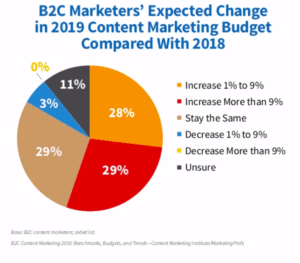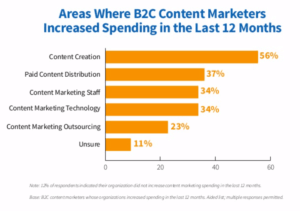
Top 100 Content Marketing Question: How do you determine budget? 10 budget rules of thumb

It’s the most wonderful time of year: budget time.
Here are 10 budget rules of thumb I developed as a manager, director and vice president. Plus, you’ll find insights on what marketers are doing with increases in content marketing budgets.
Content marketing budgets up in 2019
Most consumer marketers expect their content marketing budget to increase in 2019, says the Content Marketing Institute/Marketing Profs 2019 research.

And half of B2B marketers expect a 2019 budget increase. More than half of the most successful content marketers expect a budget increase this year.

Where will marketers spend added budget for content marketing?
According to the Content Marketing Institute/Marketing Profs 2019 research, B2B marketers apply the added budget to content creation, content marketing staff and paid content distribution:

The CMI/Marketing Profs research showed a slightly different focus in B2C content marketing: content creation, paid content distribution, and content marketing staff.

Are you struggling to get the budget you need for content marketing? I’ll offer 10 budget rules of thumb, designed to help you get the resources you need to succeed.
Ten rules of thumb: 1. Assume a zero-based budget
Assume that you will get zero budget for the coming year. Yeah, I know that sounds harsh.
For example, Walgreens is one company that uses zero-based budgeting, says The Wall Street Journal.
If your company gets a new CFO, hits a market downturn or gets acquired, next year’s Marketing budget is likely to start at zero anyhow. It’s much better to do a zero-based budget exercise before anyone tells you to.
Ask:
- Which programs, events and projects are so compelling that your CEO and CFO would find the funds to do them?
- Which Marketing work would Sales be willing to pay for from its budget?
- Which Marketing work would R&D or product development happily fund, if they knew the Marketing budget was zero?
The result of asking these questions? A list of essential programs, including:
- Marketing programs with proven high returns on marketing investment (ROMI)
- Digital media, events, channel support and account-based marketing that Sales needs
- New product launches and continuing support for growth products.
Bake these essential projects into your first-draft budget. They’re going to happen anyway. That’s the first budget rule of thumb.
2. Reach an understanding with your CFO
A key decision-maker on Marketing budgets is your chief financial officer (CFO). Your Marketing leader needs to have a heart-to-heart talk with the CFO that goes like this:

“For each expense dollar in the Marketing budget, how much revenue does the company need to increase its profits?”
That number varies, depending on your company, its industry and economic conditions.
But asking your CFO this question can establish a useful budget rule of thumb and a much better understanding of Marketing’s role in the Finance Department.
In several companies where I worked, each $1 invested in Marketing needed to bring back $3 in revenue.
Once you learn the number, ask the CFO: “So, for each $3 Marketing brings in, you’ll invest $1 more in marketing?”
Smart CFOs say yes.
After you identify the essential projects, prioritize Marketing programs according to how much revenue you expect each to bring in.
It’s easiest to do this with new product launches. It’s wise to apply the same discipline across Marketing.
“What’s the return on investment (ROI) on content marketing?” is a question that marketers frequently get asked.
But ROI is the wrong question. Here’s why: return on marketing investment (ROMI) is the right question.
The same question can be asked about almost anything in Marketing or any other department. The truth often is, usually no one knows:
- “What’s the ROI on this brochure?”
- “What’s the ROI on that video?”
- “What’s the ROI on that trade show?”
Better to ask, what’s the ROMI for a business unit’s overall marketing program, or for a specific product line’s marketing program.

The point: Measure marketing systems and programs, not one-off projects. It’s the cumulative effect of the marketing system that matters most.
3. Squeeze out savings
Now, circle the biggest line items in your budget and ask: How can we squeeze savings out of this work? Can we:
- Change vendors?
- Reset expectations?
- Do less because it isn’t necessary to do as much?
- Stop doing the project altogether?
For example, as a manager with a million-dollar budget for a Fortune 50 company’s annual report, I directed an outside graphic designer to figure out how to save 20%.
Almost a year later, after lots of huffing and puffing, our savings totaled zero. Ouch!
The next year, I hired a new designer with the same instruction: save 20%. Our new designer understood how to save by making a few small moves – specifying lighter paper, bidding the printing more competitively, and watching every penny.
Both years’ reports came out great. Virtually no one noticed the subtle differences between the more expensive report and the less expensive annual report.
Who did notice the difference? Our CEO. He sent a hand-written note to congratulate me on saving $200,000, a note I treasure to this day.
Why did he recognize that savings? Because no one had told me or asked me to save 20% on the annual report.
I just wanted to see if it could be done without affecting overall quality. Yes, it could.
Don’t wait for someone to force you to cut your budget. Instead, ask: Where are your opportunities to save without affecting quality?
4. Find out what’s working and what’s not
Companies do most marketing programs because … they’ve always done them.
Inertia rules the budget. The status quo is king.
The Marketing budget dwells in the company’s comfort zone.

That’s why it can be so hard to get budget for new initiatives such as content marketing or rebranding.
But repeating the same work Marketing did last year doesn’t always make sense. Instead, ask, “What’s working now? What’s not working?”
For example, in another Fortune 50 company, a business unit budgeted $1 million for its PR agency every year. When my team added this business unit to our portfolio, its marketing director asked, “How much budget do you need for our PR agency next year?”
“Zero,” we answered.
She was shocked. “How can you do that?”
“Because you’re not getting anything for your $1 million.”
Context: $1 million was small change to a big business unit, especially compared with its advertising budget. But $1 million was big money to my team.
We knew we could deliver more for less because after 3 meetings with the PR agency, they could not show any value they created. Zip. Zero. Nada.
What’s worse: they’d been getting away with this scam for years.
We fired the agency and moved their work in-house. And we got more news media coverage than before with our existing staff.
Less budget, more results.
Careful: If you don’t monitor closely enough and don’t hold your agencies’ feet to the fire, you are asking to get ripped off.

To measure what’s working and what’s not, apply an all-in analytics approach.
Focus on which work contributes revenue and customers, then trace that revenue back to the marketing systems that created it.
Attribution of results to individual marketing projects is hard, sometimes impossible.
For example, consider that 2/3rds of social sharing is dark sharing, where shares are untraceable and untrackable. Yet dark shares reach customers and have impact.

Attributing results to marketing programs and systems is becoming easier with artificial intelligence (AI), but it still has a long way to go.
5. Include staff costs in project budgets
Many marketers and internal clients put together a budget that assumes people are “free,” or a sunk cost that will be spent in any case.
If your company has layoffs, merges with another company, or gets acquired, a CFO will quickly teach you to appreciate the cost of your people.
Include the cost of your people’s time in project estimates.
Why? Because your team is not an unlimited free resource, which can take on any assignment someone dreams up.
That’s where most bad, wasteful marketing comes from – the mistaken impression that the Marketing staff is free. As Ann Handley cautions, Marketing can’t be treated like order-takers working behind a deli counter.
When my team felt treated like order-takers, the more vocal among them would ask, “Would you like fries with that?”
In one company, we calculated our team’s fully-loaded average hourly rate: about $200 an hour (including compensation, benefits, office space and equipment).
Why was that valuable to know? Because we communicated our hourly rate to everyone on the team with these instructions:
- If the company needs expertise that we lack internally, make sure there’s money in the budget to rent an expert.
- If you can outsource work for less, do so.
- If you can insource work for less, do so.
Following this budget rule of thumb made managing the budget everyone’s job, as it should be.
6. Take the long view
Too often, Marketing budgets are hamstrung by the short-term needs of public companies that report quarterly.

If all a company wants to do is make its numbers next quarter, no matter what, it avoids making long-term investments to build brands or create long-lived content marketing assets.
Make every Marketing budget decision with an eye to the long term.
I learned that budget rule of thumb the hard way, over 15 years as a vice president. If my decision time-frames got too short-sighted, it hurt our brand and our company’s future.
In practical terms, this budget rule of thumb means:
- Invest in long-term assets first. Think about assets that take time to build, such as brand and content, in terms of years, not quarters or months – the same way you’d think about building a house.
- Invest in systems that connect the dots from marketing spend to revenues. You need to know what’s working and have the evidence to prove it to others.
- Recognize valuable assets that others might take for granted. How could you increase value by taking a different approach to the same asset?
For example, one of my companies produced a customer magazine for 25 years. Over that time, the company built up a fantastic subscriber list.
But the magazine was a boring rehash of product brochures, issued quarterly.
What the magazine needed was a shift from company-centric product marketing to customer-centric content marketing.
So we hired freelance journalists from the best industry trade publications to write our magazine. That shift helped the magazine hit its stride and reach its potential.
I’ll never forget the day that our top sales executive exclaimed, “When I go on sales calls, I see our magazine in every customer’s office! How did we do that?”
7. Build contingencies into project budgets
Assume things will go wrong during projects. Because they almost always do.
Budget an extra 10% or 15% in contingency, so your project doesn’t go over budget.
Bonus: If, in the end, you don’t need that money for a project, reinvest it in learning and experiments. Because opportunities will come along too.
8. Protect your learning budget
A learning budget includes two essential things:
- Training – Marketing is a field that moves so fast, your team needs to learn new things every year. No matter how small your budget, never cut training – because smart, educated people will get your more results from any size budget.
- Experimentation – Innovation is everyone’s job in marketing. Set aside 10% to 15% of your annual budget to perform experiments, large and small. Here are ideas on how to create a test and learn environment.

9. Take a quota
Sales has to meet quotas. How about a revenue quota for Marketing?
Once I wanted to hire a marketing manager at a time when the company was laying off people. I told the CEO, “All I need is one more person to make this program take off.”
He said, “OK. If I give you this headcount, how much revenue will you bring me?”
“$1 million,” I said, pulling a number out of the air.
“$1 million this year,” he said.
Gulp. Tough to do when our average sales cycle was 12 to 24 months.
“Yes.”
“Deal.” We shook hands.
Then we hired a manager, implemented marketing automation, identified products with a shorter sales cycle, and beat our quota.
In fact, this program generated $2 million the first year, and $3 million the second year – versus our quota of $1 million.
Maybe you see a quota for Marketing as heresy. I see it as a budget rule of thumb – a way to increase Marketing’s budget over time by demonstrating our revenue contribution.
Marketing is part of the revenue department. Shouldn’t Marketing produce revenue?
10. Consider budget averages last
Do this step last: Consider how other marketers are spending their budgets.
For example, the 2018 Content Marketing Institute/Marketing Profs study shows that the most successful B2B marketers are putting 40% of their budgets into content marketing.

The most successful B2C marketers are putting 26% of their budgets into content marketing.

Should your budget look just like theirs?
No.
These numbers are problematic because:
- Survey respondents self-select.
- These companies have no agreed-on definition of “content marketing.” Since the definition varies widely from company to company, so do “content marketing budgets.”
- This budget is an average of what everyone does, but what your company needs to accomplish in Marketing may not be achievable by being average. Place the needs of your customers, marketplace and company before any average budget amount.
Use this budget rule of thumb: look at other companies’ spending last. Not first!
Set your budget for next year with these rules of thumb:
- Assume a zero-based budget.
- Reach an understanding with your CFO.
- Squeeze out savings.
- Find out what’s working and what’s not.
- Include staff costs in project budgets.
- Take the long view.
- Build contingencies into project budgets.
- Protect your learning budget.
- Take a quota.
- Consider budget averages last.

“How do you determine budget?” is one of marketers’ Top 100 Questions about content marketing. Here are the answers.




